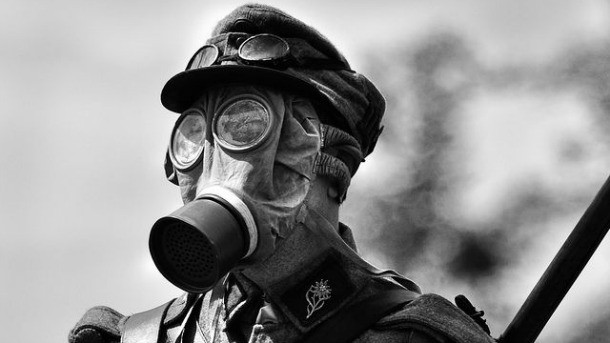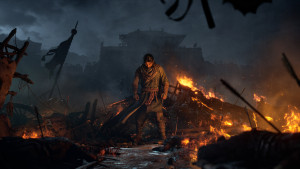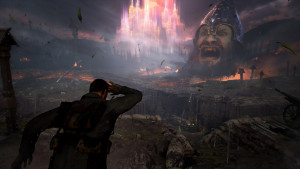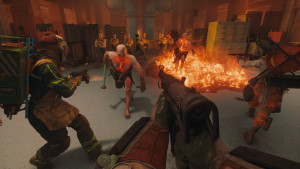Last chance for early bird pricing! Subscribe by June 25th to receive the debut issue
Four Reasons World War I Works For Battlefield, And Two Reasons It Doesn’t

This story was originally published March 5.
Over the weekend, a retailer may have accidentally leaked the setting for Battlefield 5. It could have been a typo or a joke gone awry, and was promptly removed from the site after people started buzzing. Still, the thoughts of a World War I Battlefield game is rattling around our brains. Would a game set in a war known for trench warfare, years-long stalemates, and poor military tactics that led to ridiculously large casualties really work within the Battlefield paradigm? The more we read about the war, the more we think there is a way DICE could make it work for its venerable multiplayer shooter series.
Contrary to prevailing sentiment, World War I wasn't just all chemical warfare from entrenched positions. Over the course of the four years of conflict involving six continents, the Great War featured large-scale naval battles, romanticized aerial dogfights, tank battles involving hundreds of armored vehicles, and aggressive technological innovation – plenty of fodder for DICE to make an interesting multiplayer shooter.
Here are a few reasons why World War I could work for Battlefield, and a few reasons why it it wouldn't, for good measure.
WHY IT WOULD WORK

WWI Is Largely Unexplored In Video Games
Two generations ago, everyone complained about the overabundance of World War II based shooters. Last gen became an arms race to make modern military shooters. Now we're seeing a glut of science-fiction focused FPS games, with franchises like Titanfall, Star Wars Battlefront, all three Call of Duty varieties, and Evolve joining the Dooms and Halos of the world with futuristic weaponry. By taking Battlefield to World War I, DICE will have a huge point of differentiation working in its favor.
The Great War also takes second billing to World War II in modern entertainment, so setting a game during this time period also affords DICE an opportunity to teach people about a huge part of history they are likely unfamiliar with. While the majority of people think mainly of the battles of mainland Europe, in reality the war extended its reach far across the globe, with skirmishes in Africa, the Middle East, the Pacific Islands, China, and the coasts of both North and South America. That affords DICE a wealth of varied options when designing maps.
Battlefield's Trademark Land, Air, and Sea Battles Translate Well
When you see pictures of World War I, they are often from the perspective of trenches, where defensive battles between the Central Powers and Allies resulted in heavy casualties thanks to strong defensive strategies and limited offensive options that could break the stalemates. But while infantry combat may have been a major part of the war, we also saw large-scale naval conflicts, the rise of air supremacy, and the birth of the tank.
Yes, many of the standing armies heavily used horses, camels, and other beasts of burden in a military capacity, but as the war dragged on the technology aggressively ramped up. By the end of the war, modern military staples like tanks, planes, anti-air vehicles, armored cars with machine-gun turrets, aircraft carriers, submarines, and battleships all saw extensive action. These elements already translate perfectly into the battlefield.
DICE could also have fun with some of the weird technology that was used during the war, like observation balloons, acoustic locators, and fake horse carcasses snipers used as camouflage.

Aviation Could Be Great Fun, And More Balanced
By the time the war started in 1914, aircraft were already being used militarily, primarily for reconnaissance and close air support. To counter air supremacy, World War I saw the introduction of anti-aircraft guns and fighter aircraft. Aces became the biggest celebrities of the war, with pilots like Eddie Rickenbacker and Manfred von Richthofen (a.k.a. the Red Baron) gaining popularity for their exploits.
Air supremacy has always been a major component of Battlefield, so this rich history is just waiting to be tapped by the series. The aircraft of the time weren't as dominant as modern birds of war (a problem you see DICE continually wrestle with in modern Battlefield installments), which could help keep the air game in better competitive balance with the ground operations.
Weapons Fit The Battlefield Class System
World War I didn't have an abundance of automatic rifles and machine guns, but that doesn't mean DICE has to completely rework its class system. Enough options exist in most weapon categories to preserve the Assault, Engineer, Support, and Recon division of labor should the studio go that route.
With more than 20 different standing armies participating in the war, the Assault and Recon classes would have an abundance of options to choose from for bolt-action rifles. Some will be familiar to those who have played World War II games, such as the M1903 Springfield, M1891 Mosin-Nagant, and Pattern 1914 Enfield. Machine guns were largely stationary for the early years of World War I, but light machine guns like the BAR, Lewis Gun, and MP 18 were introduced toward the end of the conflict.
The Engineer class poses more of a problem, but solutions do exist. Infantry proved largely ineffective against armored fighting vehicles in World War I, so military engineers started to develop armor-piercing bullets, "reverse bullets" that had increased propelling charge over standard issue bullets, and eventually anti-tank rifles like the Mauser 1918 T-Gewehr. You could also arm the engineer class with mortars to fight off the tank advancements.
WHY IT MAY NOT WORK

Progression System Could Prove Problematic
The amount of weaponry used in World War I is staggering, but scopes and attachments for standard issues were a rarity, meaning DICE would need to get clever in developing an unlock system for progression. As a silver lining, the stripped-down nature of combat could force DICE to spend more time on competitive balance, even if it comes at the cost of continually getting new gadgets to play with. The crazy gas masks of the time give the studio some interesting cosmetic options to explore.
Are Players Looking For Slower Paced Combat?
One reality DICE simply won't be able to work around is the fact that the pacing of combat in World War I is significantly slower than you'll find in both modern and sci-fi shooters. Don't get me wrong, I don't expect trench warfare and mustard gas to play a dominant role in multiplayer maps – enough large-scale battles that resulted in serious progress for one side or the other occurred that DICE can give us a good variety of battles. But even taking this into account, there's no denying that the tanks are slower, planes are clumsier, and infantry guns fire at a slower rate in World War I. How the market reacts to this different pace would go a long way to making or breaking Battlefield 5.
We still don't know if the World War I setting is real, or if this listing was just a snafu or playful misdirection. But if DICE does go with World War I for Battlefield 5, we think it would be an interesting and entertaining challenge.









